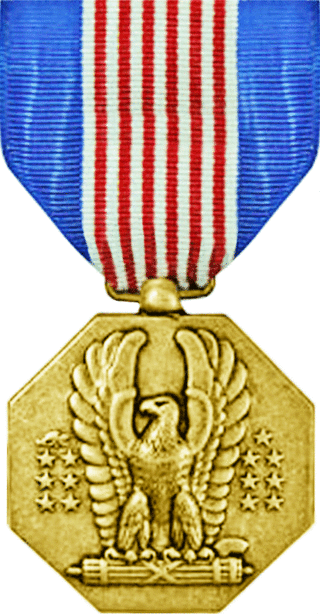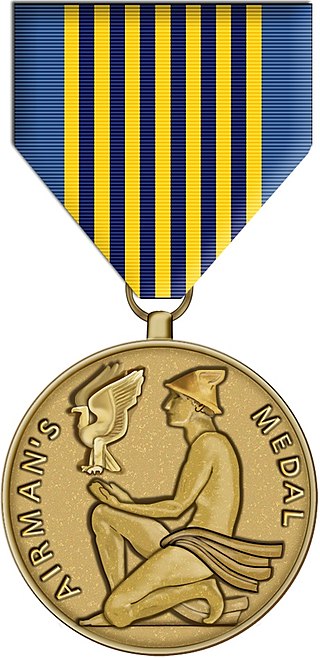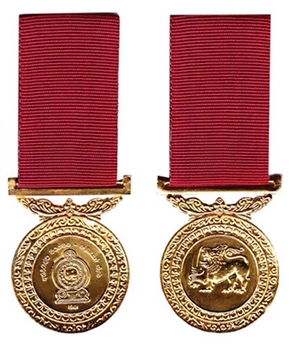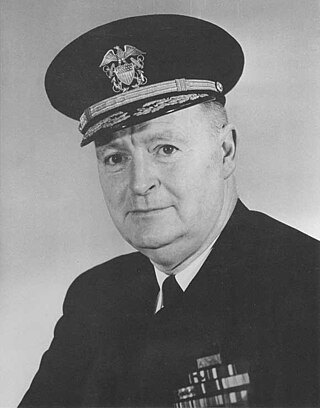
The Navy and Marine Corps Medal is the highest non-combat decoration awarded for heroism by the United States Department of the Navy to members of the United States Navy and United States Marine Corps. The medal was established by an act of Congress on 7 August 1942, and is authorized under 10 U.S.C. § 6246.

The Soldier's Medal is an individual decoration of the United States Army. It was introduced as Section 11 of the Air Corps Act, passed by the Congress of the United States on July 2, 1926. The Soldier's Medal is equivalent to the Navy and Marine Corps Medal, the Air and Space Forces' Airman's Medal, and the Coast Guard Medal. Prior to the creation of the Airman's Medal in 1960, airmen were awarded the Soldier's Medal.

The Airman's Medal (AmnM) is a military award and decoration of the United States Air Force and United States Space Force for personnel who distinguish themselves by heroism involving voluntary risk of their life not involving actual combat with an armed enemy of the United States. The medal was established on 6 July 1960 by 10 U.S. Code 8750 and is awarded to those service members or those of a friendly nation who, while serving in any capacity with the U.S. Air Force or U.S. Space Force. The performance must have involved personal hazard or danger.

The Gold Lifesaving Medal and Silver Lifesaving Medal are U.S. decorations issued by the United States Coast Guard. The awards were established by Act of Congress, 20 June 1874; later authorized by 14 U.S.C. § 500. These decorations are two of the oldest medals in the United States and were originally established at the Department of Treasury as Lifesaving Medals First and Second Class. The Department of the Treasury initially gave the award, but today the United States Coast Guard awards it through the Department of Homeland Security. They are not classified as military decorations, and may be awarded to any person.

The Royal Humane Society is a British charity which promotes lifesaving intervention. It was founded in England in 1774 as the Society for the Recovery of Persons Apparently Drowned, for the purpose of rendering first aid in cases of near drowning.

The Medal of Valor is the Armed Forces of the Philippines' highest military honor awarded for a conspicuous deed of personal bravery or self-sacrifice above and beyond the call of duty that distinguishes the recipient from his comrades. It is defined in the Philippine Army Awards and Decorations reference material FC 1–0062, itself adapted from the Armed Forces of the Philippines Awards and Decorations Handbook, Second Edition published in 1997, as an award for "heroism in combat" and is foremost in the order of precedence of awards and decorations of the Armed Forces of the Philippines.

Thomas Eadie was a United States Navy diver and a recipient of America's highest military decoration - the Medal of Honor.

The Parama Weera Vibhushanaya (PWV) is Sri Lanka's highest military decoration, awarded for acts of exceptional valour in wartime. Parama Weera Vibhushanaya translates as the "Order of Supreem Heroism", and the award is granted for "individual acts of gallantry and conspicuous bravery of the most exceptional order in the face of the enemy". Corporal Gamini Kularatne, was the first recipient. As of January 2021, the medal has been awarded 31 times, of which all were posthumous and arose from actions in the Sri Lankan Civil War. Of the 31 awardees, 28 have been from the Sri Lanka Army, two have been from the Sri Lanka Navy and one has been from the Sri Lanka Air Force.

Patrick Henry Brady, is a retired United States Army major general. While serving as a helicopter pilot in the Vietnam War, he received the Medal of Honor, the nation's highest military decoration for valor.
Alexander Noble Hall, sometimes known as Sandy Hall, was a professional soccer player who played as a centre forward in the Scottish League for Dunfermline Athletic, Dundee, Motherwell and St Bernard's. Born in Scotland, he was a part of Canada's gold medal-winning 1904 Olympic team and finished the tournament as joint-top scorer, with three goals. The goals came in the form of a hat-trick in a 7–0 win over the United States, represented by Christian Brothers College.

The ROTC Medal for Heroism is the highest United States Department of the Army medal awarded exclusively to Army Reserve Officers' Training Corps cadets. This award is presented to cadets who perform acts of heroism. As with other Department of the Army decorations, the award consists of a medal and ribbon, accompanied by DA Form 638. In the Army, this award is also known as the Medal of Heroism.
The Carnegie Hero Fund Trust is a Scottish charity. It was established in 1908 as a British extension to the Carnegie Hero Fund Commission which had been founded in 1904 in Pittsburgh, Pennsylvania. The Trust was founded upon a financial endowment from the Scottish philanthropist and steel magnate Andrew Carnegie. The purpose of the Trust is to provide payments to individuals who have been injured or financially disadvantaged as a result of undertaking an act of heroism or in fatal cases to provide for the family or other dependants. This has continued to be the aim of the Trust which each year considers around twelve cases of heroism within a geographical area encompassing Great Britain, Ireland, the Channel Islands and the surrounding territorial waters.
The United States' Federal Bureau of Investigation instituted an Honorary Medals Program in 1989 as a way of recognizing "exceptional acts" by FBI employees and other law enforcement personnel working with the FBI. These medals were created to supplement the then-existing reward system within the Bureau. There are four medals in the program intended for personnel: the FBI Star, the FBI Medal for Meritorious Achievement, the FBI Shield of Bravery, and the FBI Medal of Valor. One additional medal, the FBI Memorial Star, is for a surviving relative when a death has occurred in the line of duty. These medals are considered to be among the highest honors granted by the FBI, and fewer than 400 had been awarded as of March 2009.

Alexander Gordon Lyle was an officer in the United States Navy who received the Medal of Honor for his actions during World War I. He is one of only three dental officers to have received the medal, the others being Weedon Osborne and Ben L. Salomon.
The British Hero of the Holocaust award is a special national award given by the government of the United Kingdom in recognition of British citizens who assisted in rescuing victims of the Holocaust. On 9 March 2010, it was awarded to 25 individuals posthumously. The award is a solid silver medallion and bears the inscription "in the service of humanity" in recognition of "selfless actions" which "preserved life in the face of persecution".

The Secretary of the Army Award for Valor was an award that acknowledged acts of heroism or bravery connected with a United States Army soldier or Army activity, or that in some way benefits the Army. The equivalent military decoration for this award is the Soldier's Medal.
The Harwick Mine disaster was a mining accident on January 25, 1904 in Cheswick, Pennsylvania, some sixteen mi (26 km) north of Pittsburgh in the western part of the state. The blast killed an estimated 179 miners and 2 aid workers. The disaster ranks among the ten worst coal mining disasters in American history. One community especially impacted was the Hungarian community in Homestead, Pennsylvania. Fifty-eight of the members of the First Hungarian Reformed Church of Homestead—a full third of the congregation—died in the explosion.

William Shemin was a Sergeant in the U.S. Army during World War I. He was awarded the Medal of Honor for bravery in action at Vesle River, near Bazoches, France. On June 2, 2015, Elsie Shemin-Roth and her sister Ina Bass accepted the nation's highest military award for valor on behalf of their father from President Barack Obama at the White House. Shemin was assigned to Company G, 47th Infantry Regiment, 4th Division, American Expeditionary Forces.
Robert Salvador is a retired Philippine Army officer and a recipient the Philippines' highest military award for courage, the Medal of Valor.














